
Browse an alphabetical list of photographs. These historical images portray people, places, and events before, during, and after World War II and the Holocaust.
<< Previous | Displaying results 501-550 of 2641 for "Photo" | Next >>
View of the camp for Roma (Gypsies) in Lodz. The original German caption for this photograph was: "Zigeunerlager" (Gypsy camp), #137. In the autumn of 1941, German police authorities deported some 5,000 Roma from Austria to the ghetto for Jews in Lodz, where they resided in a segregated section (part of which is shown in this photograph). Photograph taken between 1940 and 1944.
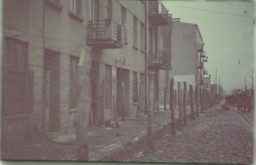
Canadian troops of the 'B' Company, North Shore (New Brunswick) Regiment take cover on June 6, 1944, or D-Day.
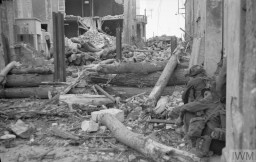
Candles mark the railway tracks leading to the Auschwitz camp during the commemoration of the 60th anniversary of the liberation of the camp. Poland, January 27, 2005.

Medical corpsmen of the US 71st Infantry Division, 3rd US Army look on as captured German soldiers remove bodies from inside a barracks in Gunskirchen. In the foreground, a Jewish girl lies huddled in the straw on the floor of the barracks. Gunskirchen, Austria, May 7, 1945.
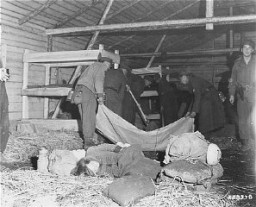
Jewish resistance fighters who were captured by SS troops during the Warsaw ghetto uprising. Warsaw, Poland, April 19-May 16, 1943. The original German caption reads: "These bandits offered armed resistance."
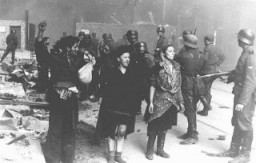
German soldiers arrest Jews during the Warsaw ghetto uprising. Poland, May 1943. The Warsaw ghetto uprising began on April 19, 1943, after German troops and police entered the ghetto to deport its surviving inhabitants. By May 16, 1943, the Germans had crushed the uprising, deported surviving ghetto residents, and left the ghetto area in ruins.
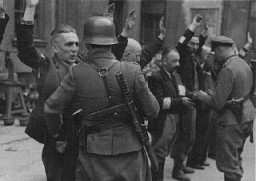
The sign erected by the 9th Armored division on the Ludendorff bridge after its capture. March 11, 1945. US Army Signal Corps photograph taken by W. Spangle.
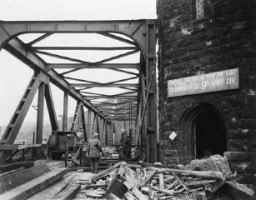
Refugee passengers of the SS Quanza sent a large bouquet of red roses and this message to First Lady Eleanor Roosevelt to thank her for her help. The First Lady made sure President Roosevelt saw both the flowers and the card, which were displayed prominently outside his bedroom.
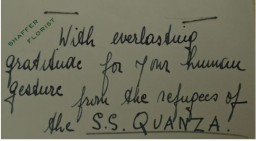
Caricature of Nuremberg International Military Tribunal defendant Alfred Rosenberg, by the German newspaper caricaturist Peis. Nuremberg, Germany, October 1, 1946.
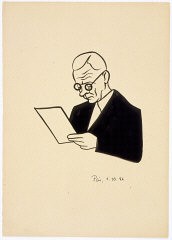
Soon after liberation, a camp survivor receives medical care. Bergen-Belsen, Germany, after April 15, 1945.
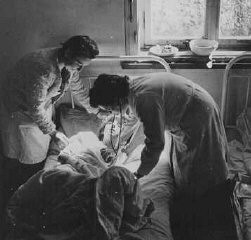
Soon after liberation, British medical officers begin disinfection of camp survivors. Bergen-Belsen, Germany, May 1945.
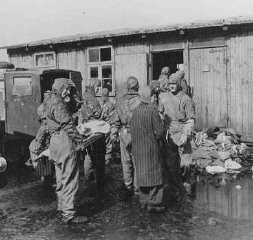
Survivors of the Wöbbelin camp wait for evacuation to an American field hospital where they will receive medical attention. Germany, May 4-6, 1945.
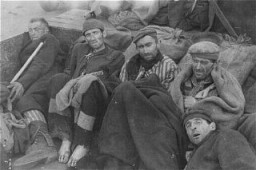
Survivors in Wöbbelin board trucks for evacuation from the camp to an American field hospital for medical attention. Germany, May 4–5, 1945.
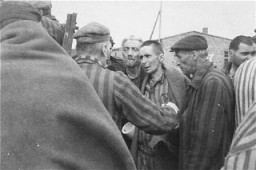
Carl Goerdeler, former mayor of Leipzig and a leader of the July 1944 conspiracy to kill Hitler, stands trial before the People's Court in Berlin. He was condemned and executed at Ploetzensee prison on February 2, 1945. Berlin, Germany, 1944.
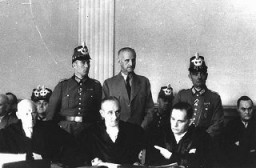
Catholic clergy and Nazi officials, including Joseph Goebbels (far right) and Wilhelm Frick (second from right), give the Nazi salute. Germany, date uncertain.
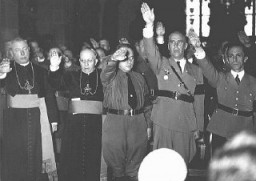
Members of the Chug Ivri (Hebrew Club) in Berlin celebrate Purim with food and song. On the wall is an advertisement for Juedische Rundschau, the newspaper of the German Zionist movement. Berlin, Germany, 1935.
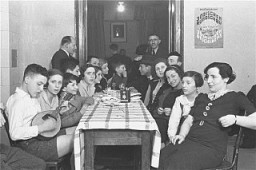
Members of Chug Ivri (Hebrew Club) of Berlin celebrate Purim. While the man in the tallis (prayer shawl) chants the story of Purim from the scroll, a young boy stands ready to use his grogger (noisemaker) to drown out the recitation of the name of Haman, the villain of the story. Berlin, Germany, 1935.
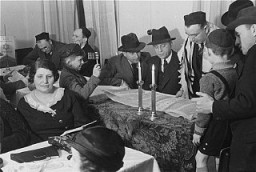
Blanka (right) with her daughter, Shelly, after Shelly's wedding. New York, 1974.
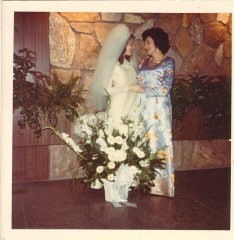
Naftali Saleschutz (Norman Salsitz) prepares cement for the foundation of a sukkah (a hut-like structure used to celebrate the Jewish holiday of Sukkot). Kolbuszowa, Poland, 1937.
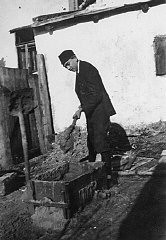
Adolf Hitler and other participants in the Hitler Putsch, during the annual anniversary celebration of his failed attempt to seize power. Behind Hitler stand Rudolf Hess (left) and Heinrich Himmler. Munich, Germany, November 9, 1934.
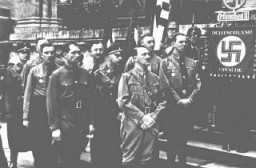
Cemetery at Hadamar. This photograph was taken toward the end of the war. Hadamar, Germany, April 1945.
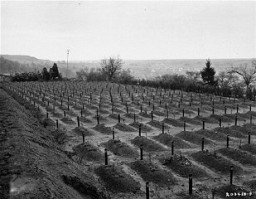
Closing ceremonies of the 4th Winter Olympic Games. Garmisch-Partenkirchen, Germany, February 16, 1936.
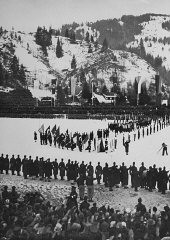
British prime minister Neville Chamberlain (left), German chancellor Adolf Hitler (center), and French premier Edouard Daladier (right) meet in Munich to determine the fate of Czechoslovakia. Germany, September 30, 1938.
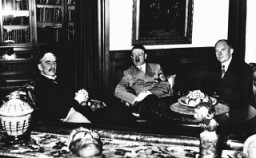
During an inspection by US Army chaplains of the newly liberated Buchenwald concentration camp, G. Bromley Oxnam (right) views a demonstration of how prisoners were tortured in Buchenwald. Oxnam was the Methodist bishop of New York and President of the Federated Council of Churches of Christ in America. Buchenwald, Germany, April 27, 1945.
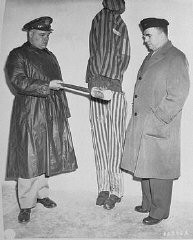
US Brigadier General Telford Taylor (front right), chief of counsel, sits at the prosecution table with his staff during the reading of charges against the defendants in the RuSHA Trial. October 10, 1947.
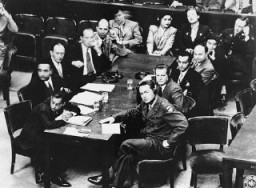
Father Charles Coughlin, leader of the antisemitic Christian Front, delivers a radio broadcast. Detroit, United States, March 11, 1935.
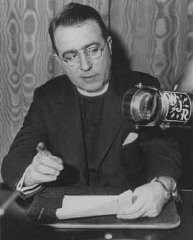
View of the charred remains of Jewish victims burned by the Germans near the Maly Trostinets concentration camp. Photograph taken ca. 1944. In the fall of 1943, the Germans destroyed the Minsk ghetto. The SS deported some Jews from Minsk to the Sobibor killing center, and killed about 4,000 remaining Jews at Maly Trostinets.
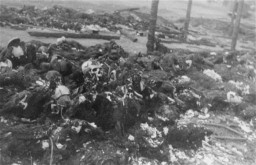
Chart illustrating the Nuremberg laws. The figures represent Germans, Jews, and Mischlinge. Germany, 1935.

Chart indicating the workforce of the Auschwitz-Monowitz camp by category and nationality of inmates. Poland, January 16, 1945.

Chart used by the prosecution in the Doctors' Trial illustrates the organization of the Medical Services of the Wehrmacht (German armed forces). Nuremberg, Germany, December 9, 1946-August 20, 1947.
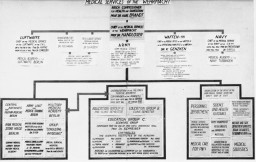
Chart with the title "Die Nürnberger Gesetze" [Nuremberg Race Laws]. In the fall of 1935, German Jews lost their citizenship according to the definitions posed in these new regulations. Only "full" Germans were entitled to the full protection of the law. This chart was used to aid Germans in understanding the laws. White circles represent "Aryan" Germans, black circles represent Jews, and partially shaded circles represent “mixed raced” individuals. The chart has columns explaining the…
![Chart with the title "Die Nürnberger Gesetze" [Nuremberg Race Laws]](https://encyclopedia.ushmm.org/images/thumb/109130bd-4617-43ad-a556-d2955f1a4aa3.jpg)
Chart showing the breakdown of Jews and Jews of "mixed race" (Mischlinge) within the total German population of 1939.
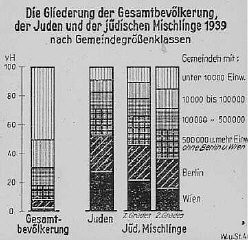
Guards check the identification papers of women entering the ghetto in Munkacs, in a part of Czechoslovakia annexed by Hungary in 1938. Czechoslovakia, 1944.
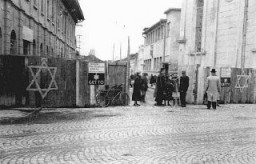
A Polish policeman checks the papers of a Jewish resident of the Warsaw ghetto. Warsaw, Poland, February 1941.
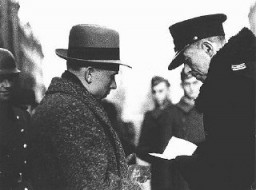
Chief Prosecutor Benjamin Ferencz at the Einsatzgruppen Trial, Case #9 of the Subsequent Nuremberg Proceedings. Photograph taken in Nuremberg, Germany, between July 29, 1947, and April 10, 1948.
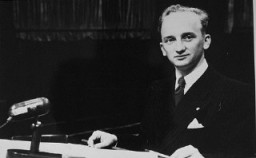
Chief Prosecutor Benjamin Ferencz presents evidence during the Einsatzgruppen Trial, Case #9 of the Subsequent Nuremberg Proceedings. Ferencz is flanked by German defense lawyers Dr. Friedrich Bergold (right, counsel for Ernst Biberstein) and Dr. Rudolf Aschenauer (left, counsel for Otto Ohlendorf), who are protesting the introduction of certain documents as evidence.
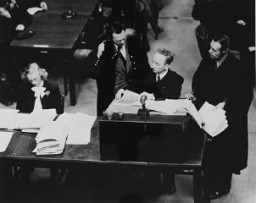
Yakob Vizgordiski works at a machine in a ghetto factory. Kovno, Lithuania, between 1941 and 1943.
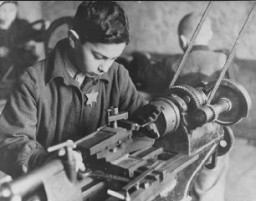
Soon after liberation, surviving children of the Auschwitz camp walk out of the children's barracks. Poland, after January 27, 1945.
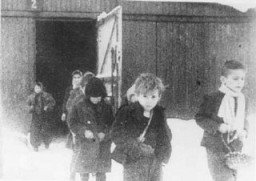
This photograph is a still from Soviet film footage of the liberation of Auschwitz. The film was made by the film unit of the First Ukrainian Front. Relief workers and Soviet soldiers lead child survivors of Auschwitz through a narrow passage between two barbed-wire fences. Standing next to the nurse and behind them (wearing white hats) are two sets of twin sisters. During the camp's years of operation, many children in Auschwitz were subjected to medical experiments by Nazi physician Josef Mengele.
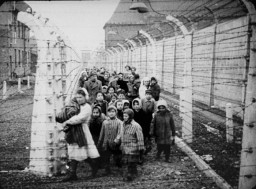
Escorted by US soldiers, child survivors of the Buchenwald concentration camp file out of the main gate of the camp. Buchenwald, Germany, April 27, 1945.
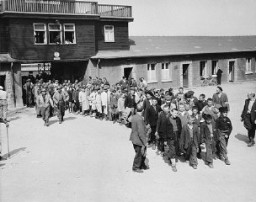
Children march out of Buchenwald to a nearby American field hospital where they will receive medical care. Buchenwald, Germany, April 27, 1945.
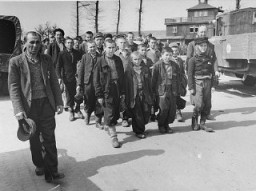
A child vendor among those selling miscellaneous wares at the market in the Lodz ghetto. Lodz, Poland, ca. 1941.
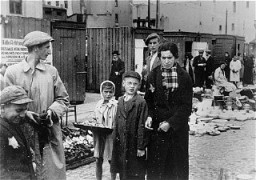
A Jewish child is forced to show the scar left after SS physicians removed his lymph nodes. This child was one of 20 Jewish children injected with tuberculosis germs as part of a medical experiment. All were murdered on April 20, 1945. Neuengamme concentration camp, Germany, between December 1944 and February 1945.
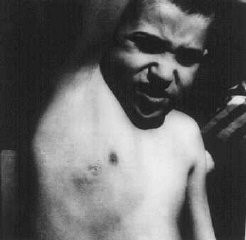
Group portrait of children dressed in Purim costumes. Danzig, 1930-1939.
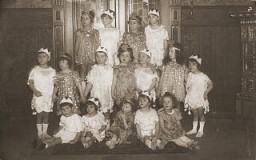
International Red Cross Poster showing photographs of children in a refugee camp in Chad. Titled "Help us find our family." Chad, 2005.
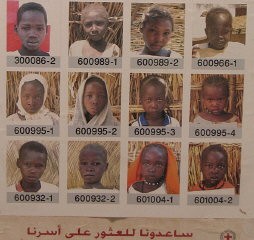
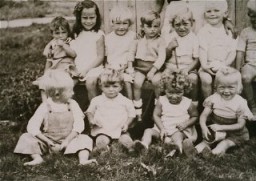
Three Jewish children in the Feldafing displaced persons camp. Feldafing, Germany, 1946–47.
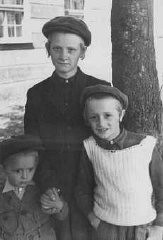
In the Warsaw ghetto, Jewish children with bowls of soup. Warsaw, Poland, ca. 1940. During the Holocaust, the creation of ghettos was a key step in the Nazi process of brutally separating, persecuting, and ultimately destroying Europe's Jews. Ghettos were often enclosed districts that isolated Jews from the non-Jewish population and from other Jewish communities.
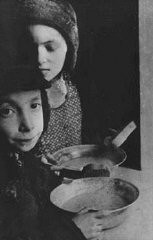
A group of children who were sheltered in Le Chambon-sur-Lignon, a town in southern France. Le Chambon-sur-Lignon, France, August 1942.
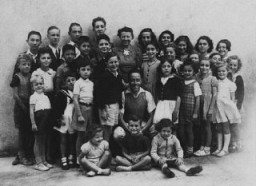
Children's painting showing of Jews celebrating Hannukah. This painting, which was probably drawn by either Michael or Marietta Grunbaum, was made in Theresienstadt and then pasted into a scrapbook by their mother shortly after liberation. Theresienstadt, Czechoslovakia, ca. 1943.
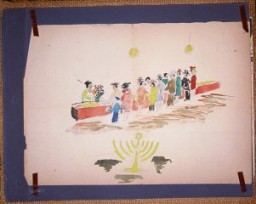
We would like to thank Crown Family Philanthropies, Abe and Ida Cooper Foundation, the Claims Conference, EVZ, and BMF for supporting the ongoing work to create content and resources for the Holocaust Encyclopedia. View the list of donor acknowledgement.